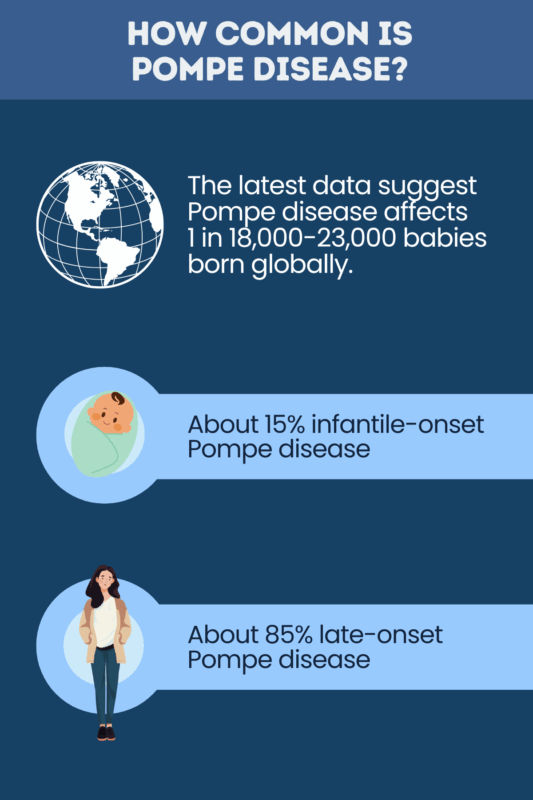
Pompe disease prevalence
Last updated July 21, 2025, by Lindsey Shapiro, PhD

Determining the exact Pompe disease prevalence is difficult because it’s a rare condition that can be challenging for doctors to accurately diagnose. But with advances in newborn screening (NBS) programs that test babies for rare genetic diseases at birth, scientists are starting to get a better picture of how many people are living with the condition.
Pompe disease is a rare lysosomal storage disorder — a group of diseases broadly characterized by a lack of enzymes needed to break down substances in the body, causing their harmful accumulation.
In Pompe, mutations in the GAA gene cause a lack of functional acid alpha-glucosidase enzyme, or GAA. That enzyme is normally responsible for breaking down a large sugar molecule called glycogen. Consequently, glycogen accumulates and causes damage, especially to muscle cells, leading to symptoms of progressive muscle weakness and low muscle tone.
How many people have Pompe disease?
Due to inherent challenges in accurately diagnosing rare diseases, it’s difficult to know the exact number of people with Pompe worldwide. Historically, estimates based on genetic data placed Pompe disease frequency somewhere around 1 in 40,000 people.
In recent years, countries including the U.S. have started to add Pompe disease to their NBS programs, which has enabled more accurate estimates to be made. Newer data emerging from these programs generally reflect that Pompe disease occurs more frequently than was previously thought.
An analysis in early 2024 used NBS data from more than 11 million newborns, screened across eight countries between 2010 and 2022. It found the birth prevalence of Pompe to be 1 in 18,711, or 5.3 cases of Pompe for every 100,000 births. Researchers believe this number is conservative, as it only accounts for cases captured via NBS at birth.
A 2021 study estimated the genetic prevalence of Pompe disease based on the proportion of people in the general population who had likely disease-causing mutations. Those results suggested that Pompe has a predicted genetic prevalence of 1 in every 23,232 people, supporting the idea that Pompe occurs more often than previously believed.

Geographical differences
Whether Pompe prevalence varies by geographical area, race, or ethnicity is a difficult question to answer due to regional differences in availability of NBS programs, diagnostic practices, and clinical awareness of Pompe disease.
Regional variations that are observed could be shaped by these differences in screening and diagnostic practices, as well as underlying genetic factors. Emerging data from existing NBS programs across the globe should help scientists more accurately determine the true geographical differences, if any, in Pompe disease incidence.
In the 2024 analysis, the birth prevalence of Pompe disease was found to not significantly vary by geographical region across populations of European, Latin American, or Asian ancestry.
Nevertheless, other reports have suggested the incidence of Pompe disease may vary by geographical region and across ethnic groups.
- A 2025 review indicated that some recent studies reported an increased birth prevalence of Pompe in people of African descent.
- In another review study and meta-analysis, the birth prevalence of Pompe disease was found to be highest in Asia and North America relative to Oceania or Europe.
- In the 2021 study, the highest predicted genetic prevalence of Pompe disease was observed in East Asian, non-Finnish European, Ashkenazi Jewish, and African/African American populations.
Prevalence of infantile-onset Pompe disease
In infantile-onset Pompe disease, known as IOPD, disease-causing mutations lead to very little or completely absent GAA enzyme activity — usually less than 1% of normal. In this more severe type of the disease, signs of the disease are usually evident in the first months of life.
IOPD is the least common form of the disease, but data on its specific incidence have been variable. The 2024 analysis of global NBS data reported that almost 15% of identified Pompe disease cases were classified as IOPD, with the birth prevalence of IOPD being 1 in 126,118, or 7.9 per 1 million babies born.
Reported IOPD rates have varied by geographical region, with some studies suggesting IOPD diagnosis may be more frequent in Asia, particularly Taiwan, than in the U.S. But as with the overall Pompe prevalence, whether there are true geographical differences in IOPD distribution will require more data.
Prevalence of late-onset Pompe disease
Generally considered the more mild form of the condition, late-onset Pompe disease (LOPD) is characterized by GAA enzyme activity up to 40% of normal and symptoms that appear in childhood or adulthood.
Of the types of Pompe disease, LOPD is the most common. A recent analysis placed the birth prevalence of LOPD at 1 in 21,902, or 45.6 per 1 million births, with almost 85% of diagnosed Pompe disease cases being classified as LOPD.
As with IOPD, geographical differences may exist. There are data indicating that a higher proportion of Pompe cases are classified as LOPD in the U.S. than in Asia, which could be related to a prevalence of milder genetic variants that skew toward an LOPD clinical profile.
Are rates of Pompe disease increasing?
Recent research reflects a higher incidence of Pompe disease than earlier estimates. However, that does not necessarily mean that more people are born with the disease now than in the past.
Advances in the ability to accurately diagnose Pompe disease early in life mean that more cases that may have been previously missed can now be accurately captured. Over time, with approaches like NBS in place worldwide, scientists will be able to better determine the condition’s frequency, or the true Pompe disease prevalence.
Pompe Disease News is strictly a news and information website about the disease. It does not provide medical advice, diagnosis, or treatment. This content is not intended to be a substitute for professional medical advice, diagnosis, or treatment. Always seek the advice of your physician or other qualified health provider with any questions you may have regarding a medical condition. Never disregard professional medical advice or delay in seeking it because of something you have read on this website.




